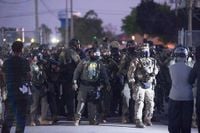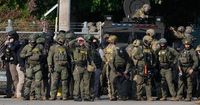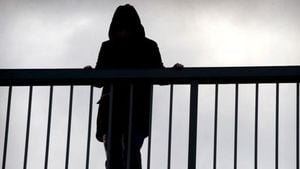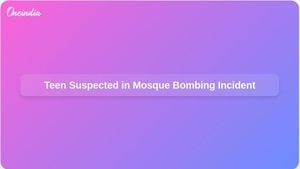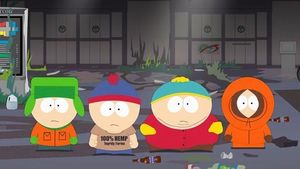In the pre-dawn darkness of September 30, 2025, the South Shore neighborhood of Chicago became the stage for one of the most forceful immigration enforcement actions in recent American memory. Federal agents, numbering over 300 and drawn from the U.S. Border Patrol, FBI, and the Bureau of Alcohol, Tobacco, Firearms and Explosives (ATF), descended upon the five-story apartment building at 7500 South Shore Drive with a show of military-style might that left residents—and the city at large—shaken and searching for answers.
Residents were jolted awake around 1 a.m. by the thunderous sound of Black Hawk helicopters hovering above their homes. Agents, clad in military gear with masks and helmets, rappelled onto the roof while others arrived in Budget and U-Haul moving trucks, surrounding the building from every angle. In a matter of minutes, flashbang grenades shattered the early morning quiet, and doors were kicked down as armed agents stormed apartments, forcibly removing men, women, and children—many still in their nightclothes or even unclothed—from their beds. According to witnesses cited by TIME and Newsweek, residents were zip-tied or handcuffed with plastic restraints and herded outside, where some sat on the street for hours, exposed to the elements and to the gaze of neighbors and passersby.
The operation was part of "Operation Midway Blitz," a sweeping federal immigration initiative launched by the Trump administration in early September. The Department of Homeland Security (DHS) has claimed that the campaign has resulted in some 900 arrests in the Chicago area alone, with 37 people apprehended in this single raid. ICE reports that nearly 200,000 people have been deported nationally in the first seven months of Trump’s second term, with some deportations occurring within days of arrest. As of September, ICE was detaining approximately 60,000 people, 71.5% of whom had no criminal convictions, according to official figures reported by TIME and CNN.
Federal authorities justified the raid by alleging that the apartment complex was “a location known to be frequented by Tren de Aragua members and their associates,” referring to the Venezuelan gang notorious for its criminal activity. Yet, as The New York Times and CNN reported, only two of the 37 people arrested were confirmed as suspected gang members. Others were detained for a range of infractions, from aggravated battery to marijuana possession. The DHS did not provide evidence linking the majority of residents to the gang, nor did they release the identities of most arrestees. The lack of transparency and specificity has fueled accusations that the operation was less about targeting dangerous criminals and more about casting a wide net over an already vulnerable community.
Perhaps the most disturbing aspect of the raid, as recounted by witnesses and confirmed by DHS statements to CNN, was the separation of families. Four U.S. citizen children were taken into custody and separated from their undocumented parents. A witness told WBEZ News, “Stuff was everywhere. You could see people’s birth certificates and papers thrown all over. It was wicked crazy.” Videos and photographs from the aftermath, published by TIME, showed toys and shoes scattered throughout the hallways—a haunting testament to the chaos and fear that gripped the building.
Illinois Governor J.B. Pritzker, along with Chicago’s Mayor Brandon Johnson and a chorus of lawmakers and civil rights advocates, condemned the raid in the strongest possible terms. Pritzker declared, “Military-style tactics should never be used on children in a functioning democracy. This didn’t happen in a country with an authoritarian regime—it happened here in Chicago. It happened in the United States of America—a country that should be a bastion of freedom, hope, and the rights of our people as guaranteed by the Constitution.”
Chicago officials, anticipating the federal crackdown, had taken steps to shield residents. Mayor Johnson signed an order instructing city law enforcement not to cooperate with federal agents, and the nearby city of Evanston issued warnings about impending raids, urging residents to report sightings of ICE agents. Despite these efforts, the sheer scale and aggression of the operation caught the community off guard.
The legal and constitutional implications of the raid have sparked fierce debate. Legal experts and organizations like the American Civil Liberties Union (ACLU) argue that the raid violated Fourth Amendment protections against unreasonable searches and seizures. No search warrants were shown, and probable cause for the mass detentions was not provided. Most of those detained were U.S. citizens, many of them Black or Latino, and were required to produce identification and citizenship papers under duress—an act that civil rights advocates say amounts to illegal search and racial profiling. Ed Yohnka of the ACLU told MSNBC, “What we saw was a full-fledged military operation conducted on the south side of Chicago against an apartment building. It was an escalation of force and violence.”
Residents’ accounts painted a grim picture. Pertissue Fisher, a U.S. citizen living in the building, recounted to ABC7 Chicago how she was handcuffed, held for hours, and released around 3 a.m. “They just treated us like we were nothing,” she said. Neighbor Eboni Watson described seeing children, some without clothes, zip-tied and led away by federal agents. “Where’s the morality?” she asked, her voice echoing the sentiment of many in the community. NAACP president Derrick Johnson added, “The trauma inflicted on these young people and their families is unconscionable.”
The operation’s aftermath has only heightened tensions in Chicago and beyond. Protests erupted outside the ICE processing facility in Broadview, Illinois, just days after the raid, resulting in at least 18 arrests. DHS Secretary Kristi Noem, who has been outspoken in support of the crackdown, posted videos of the raid on social media, overlaying dramatic music and highlighting the agency’s resolve. Meanwhile, reports surfaced of confrontations between law enforcement and protesters, including an incident in which officers were reportedly rammed by vehicles and forced to fire defensive shots. In a separate episode, Chicago Alderperson Jessie Fuentes was briefly handcuffed by ICE agents after questioning their authority at a local medical center—an incident that further inflamed criticism of federal tactics.
President Trump, for his part, has doubled down on his rhetoric, framing the raids as a necessary response to what he calls an “invasion from within.” In recent speeches, he has called for U.S. cities to serve as “training grounds” for the military and has frequently singled out Chicago as emblematic of what he deems lawlessness in Democratic-run cities. ICE Assistant Secretary Tricia McLaughlin echoed this stance, stating, “This operation will target the worst of the worst criminal illegal aliens in Chicago.”
Yet, as the dust settles, many in Chicago are left grappling with the reality that the majority of those swept up in the raid were neither violent criminals nor gang members, but ordinary people—many of them American citizens—whose lives were upended in the name of security. The scars left by the operation, both physical and psychological, are likely to linger long after the helicopters have gone. The city’s response, and the nation’s reckoning with the balance between security and civil liberties, will shape the debate for months and years to come.
